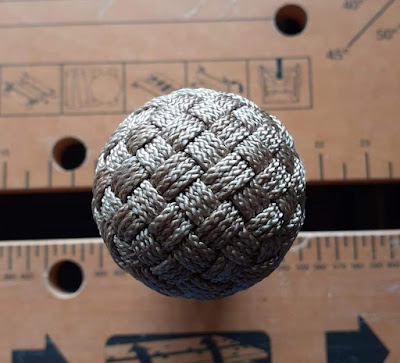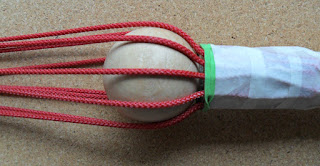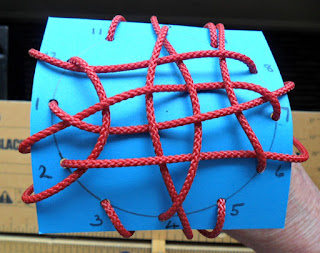This is the 12-strand crown that will be used to start the knot. This is just a guide should anyone have difficulty in forming it.
Here is a taped over piece of dowel which represents, for example, the end of a sennit in a bellrope. I have glued a 50mm. diameter wooden bead to the end to keep it steady for this tutorial. I am using 12 cords(2.8mm.) Ideally you will have made the sennit with the same cords.
This is (using Ashley's method) a piece of thin card with the 12 holes numbered to make things easier if you haven't used this method before. The diameter of the circle is 3 inches.
Thread the 12 cords through the holes as shown.
With strands 1,4,7 and 10 form the crown shown. It is just 2 interwoven overhand knots.
Using strands 2,6,8 and 12 , tuck as shown.
With the remaining strands 3,5,9 and 11 finish off the 12-strand crown.
Remove the card. I find the easiest way is to tear around the circumference of the circle. Arrange as you see here. Keep everything slack.
Helix the cords as you see here. You may have to draw some slack out of the crown to do this.
Try to duplicate what you see in all the photos. Lead all strands to the left out of the way then taking each strand in turn, go O1,U1.
All strands tucked O1,U1.
Take all strands to the left. Again go O1,U1.
All strands tucked O1,U1.
Make sure there is plenty of slack in the knot and that each compartment is roughly the same size. Try to keep everything neat at all stages. Now form a Wall knot and arrange the ends for following below the original lead.
With each strand go O1,U1,O1,U1.
Take each strand in turn and fully double the knot, bringing the ends up ready for the third and final pass.
This shows the knot fully doubled and the ends ready for the final pass.
Again, take each strand in turn and make the final pass.
Everything tripled except for the Wall. My preferred method is to not triple the Wall and bring the ends out underneath the knot at the bottom. This can be seen in the bellrope at the end of the tutorial. I'll finish here by tripling the Wall.
Everything tripled.
Take each strand in turn and fully tighten it all the way to the end.
Before trimming the ends it will greatly improve the knot if you "roll" it with a flat piece of stout wood or something similar on top of a flat surface. Trim the ends and that is the knot finished!! Just take your time and you should get the result shown here.
Good luck!
~~~~~~~~~~~~~~~
This shows the knot on the end of one of my bellropes.
The cord used was 2.8mm. venetian blind cord ( K range ) from English Braids. It is neither too "hard laid" nor "stiff".
It is a good general purpose cord. The core is a 50mm. wooden bead. Everything is the same as in the tutorial, just a different cord.
The whole bellrope.

















































